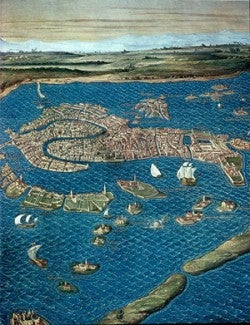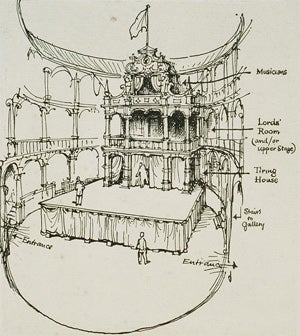A Shakespeare Gallery
Julia Reinhard Lupton
Professor of English and Comparative Literature, The University of California, Irvine
With its extraordinary image collection and sensitive search functions, Artstor has changed the way I teach Shakespeare. Images of the Globe Theater and panoramic maps of Elizabethan London set the stage for our engagement with the plays. When teaching The Merchant of Venice and Othello, I use paintings by Venetian artists to introduce students to this city of canals, carnival, and liturgical spectacle. Ignazio Danti’s full-color map provides an aerial view of the city in Shakespeare’s century. Veronese’s Wedding at Cana puts the cosmopolitan world of sixteenth-century Venice on extravagant display, with an African cup-bearer, turbaned Turks and Moors, court musicians, fantastical wedding costumes, and a stage-like setting. Gentile Bellini’s Procession in Piazza San Marco graphs the political and theological axes of public pageantry in Renaissance Venice. A thoughtful illumination of a man and woman dressed for carnival gives further insight into the Venetian theater of life. Jacob de Barbari’s woodcut map of Venice provides a detail of the Jewish ghetto, which I supplement with photographs of the ghetto today. Images of Epiphany kings represent noble Africans as members of a Pauline community, a theme tapped by Shakespeare in Othello.
- Sandro Botticelli, The Third Episode of the Story of Nastagio degli Onesti, 1483. (c) 2006, SCALA, Florence / ART RESOURCE, N.Y.
- Jacopo del Sellaio, Banquet of Ahasuerus, c. 1490. Galleria degli Uffizi .(c) 2006, SCALA, Florence/ART RESOURCE, N.Y.
- Venice: Map of City, 16th C
- Globe Theatre (Southwark, London, England), Ref.: development 1580-90(i): possible intermediate steps in the early development of English theaters
- Paolo Veronese, Marriage at Cana; detail, 1563. Musée du Louvre. Photo Credit: Erich Lessing/ART RESOURCE, N.Y.
When I teach A Midsummer Night’s Dream and The Winter’s Tale, I develop the extensive analogies between the metamorphic, seasonal, and amatory mythologies of Shakespeare’s plays and Botticelli’s Primavera. All three works display the glorious weave of holiday celebration, natural history, mythography, and courtship narratives in the Renaissance society of festival. I supplement Botticelli with examples of medieval and Renaissance calendar art. We also discuss the cassone tradition (marriage chests painted with mythological scenes) and their relevance to both the artistic output of Botticelli and the ways in which humanists and artisans in northern Europe wove classical mythology into the décor of daily life through tapestries, embroideries, and other household objects.
The Taming of the Shrew draws on falconry and animal husbandry discourses, which I introduce to students through medieval falconry guides. I also fill out Shakespeare’s bestiary with images of the hunt and animal social life.
I illuminate Richard II through the Wilton Diptych, a portable votive portrait depicting the coronation of the King by Mary and a host of angels. The painting demonstrates the power of political theology in Richard’s lifetime, tropes that Shakespeare both takes apart and rebuilds over the course of his play.
Banquets figure as settings for key scenes in plays as diverse as Romeo and Juliet, Timon of Athens, and The Taming of the Shrew. At court, Shakespeare’s plays were performed in banqueting houses. Images of Renaissance banquets bring to life the intimate relationship between hospitality, commensality and theater in the Renaissance.
Finally, in addition to these more historical and illustrative uses of visual art, I design backdrops for student readings of scenes from Shakespeare using Artstor images (often updated in Photoshop). By projecting the images against a screen, I can create instant environments for our in-class performances, greatly enhancing student learning and experience.




